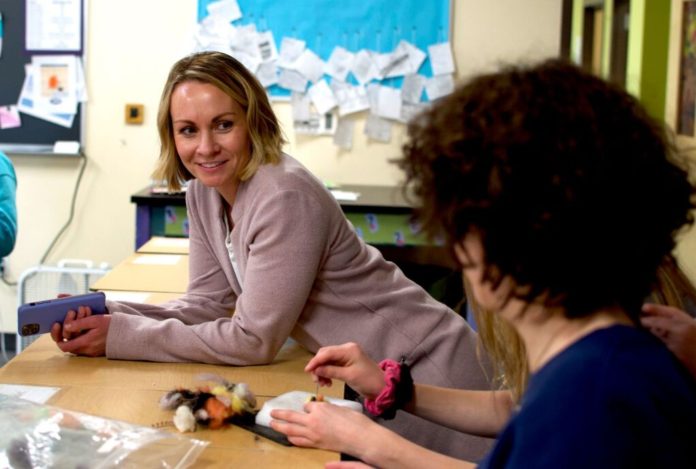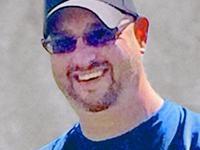Eliza Noe / Craig Press
If you walk through Craig Middle School late in the afternoon on a school day, you’re met with empty halls. You might see a student head to or from a bathroom break, but other than that, it’s very quiet. The real hustle and bustle is happening inside the classrooms, where students across the school are learning non-traditional topics — from true crime and fly tying to photography and cursive.
At CMS, these topics are called exploratories, and they’re part of principal Sara Linsacum’s revamp of the culture of the building. For the last 45 minutes of the day, students are broken down into classes that they’ve specifically chosen based on their interests, and students from grades 6 through 8 are mixed among them. Before this school year started, teachers wrote down all of the topics they felt passionate about, and students chose up to five they would be interested in taking. Each student was assigned a class from their top five. To Linsacum, it’s a win-win. Teachers get to break away from traditional curriculums to teach their hobbies, and students can learn something completely new or continue their own passions.
Though exploratories aren’t a new concept — Linsacum said that they’ve existed in some form in the past but had been nixed — they’re just part of her goal to “educate the whole child.”
“Long story short, in a middle school model, it recognizes that this is a very hard time in kids’ lives. And one of the biggest influences that we can have is by building quality relationships with students, and not just supporting them academically, but also socially, emotionally, and also their health and wellness,” Linsacum said.
One moment that sticks out to Linsacum was the first day of exploratories. She didn’t know what to expect. Was this going to turn into chaos? At CMS, 450 kids would be moving to classrooms they may not have ever been in, with a teacher they don’t know and other students they may have never had a chance to talk to.
“The first day, once we got everybody settled into exploratories, I just walked around,” she said. “And the kids were just saying, ‘Mrs. Linsacum!’ Like, they weren’t in there for 20 minutes yet. I’ve got kids in their origami class creating things (and) just super into what they’re doing. I have kids learning measurement, and they’re already chopping vegetables. I’m like, ‘This is what it’s all about. Right?’ Just seeing kids be engaged. Be excited to be here — that’s really exciting.”
In addition to exploratories, Linsacum has introduced a short physical exercise time just before lunch. For approximately 20 minutes, students learn lawn games and have social time before going to lunch during a time called “wellness.” It took some finagling with how long classes are, but now students are still getting the same amount of instruction time while having opportunities for breaks. CMS also doesn’t use school bells to dismiss students to their next classes. Teachers dismiss on their own, which Linsacum said makes the schedule less rigid.
“We base our philosophy a lot around movement patterns, but really with the outcome that every person can be physically active. You don’t have to be an athlete to be a healthy person, right? Like, so really squashing that stigma and just seeing, like, fitness is for everybody. Movement is for everybody,” she said. “What (elective teachers) do is they create about three or four different activities per every couple of weeks to introduce to the kids. And the rule is (students) have to go out, and they have to run a quarter of a mile or walk. They have to finish that. And then they can come in and participate in whatever movement activity.”
Eliza Noe / Craig Press
One result of these non-traditional additions to the school day is something that Linsacum didn’t necessarily expect when she implemented them: few to no behavioral referrals. Linsacum said this is probably because the students get regular breaks throughout the day; the longest students are in class without one is about 120 minutes. On Wednesday, there were no students in in-school detention.
“I think when kids become passionate about something, they’re more likely to engage in school,” Linsacum said “Also we purposely planned this at the end of the day, and middle school kids are done by the end of the day. And what we find now is they’re really excited for the end of the day, so it’s really shifted kind of that culture. We don’t really have office referrals.”
In one exploratory class, students gather at long tables with pieces of wool to create needle felt art. Outside the room, their works are displayed in a case, with gnomes and small colorful animals sitting for the whole school to see. Next door, others are fly tying — making an artificial fly used by fly fishing anglers to catch fish.
Ani Martinez, a student at CMS said she enjoyed exploratories — especially in her class where she did needle felts. Her art is in the display case outside of her classroom. Her classmate, Marie Roberts, echoed Martinez’s praises toward exploratories. They said it was a time where they get to be creative instead of sitting in a classroom learning traditional subjects.
In the fly tying class, students were making “wooly booger” ties that resemble black caterpillars. One student said that he preferred the tie dying class he took earlier this year, but that’s the beauty of exploratories. Since they only last five weeks, students move on to other subjects quickly and they’re not in a class they hate for a long time.
Linsacum said that along the way, she hopes community members will want to get involved in exploratories. One teacher is introducing a “careers” class, where students will get to hear from various professionals about their jobs.
She reiterated that the end goal was to make sure each student had a strong relationship with at least one teacher and that she wanted to move CMS away from “my students” to “our students.”
Though it could have been easy to stick to the status quo and continue what had already been done, Linsacum wanted to challenge current thinking and change traditional methods. Collaboration among all teachers at CMS is the key to making this happen, she said, and though a lot of these changes came this year, there was already a foundation for improvement that came through CMS staffs before her.
“It is the teachers,” Linsacum said. “They have been on a team having to say, ‘Well, we’re going to create the system, and what’s good for sixth graders is good for eighth graders.’ It’s really looking at our school as a whole: Our kids in our school in our classrooms. They’re doing our curriculum and our activities. It’s making us look at it through that lens.”
Credit: Source link






























